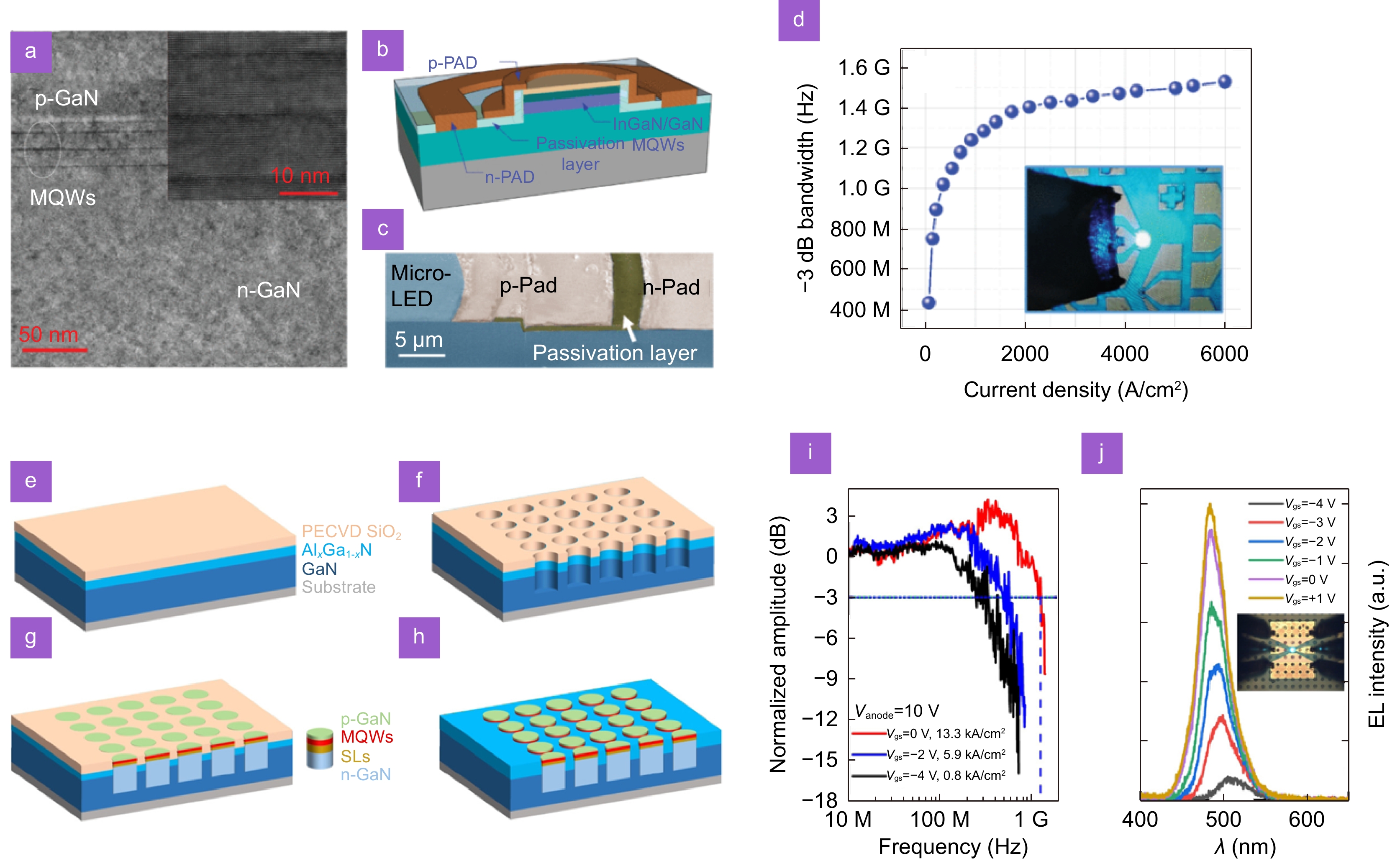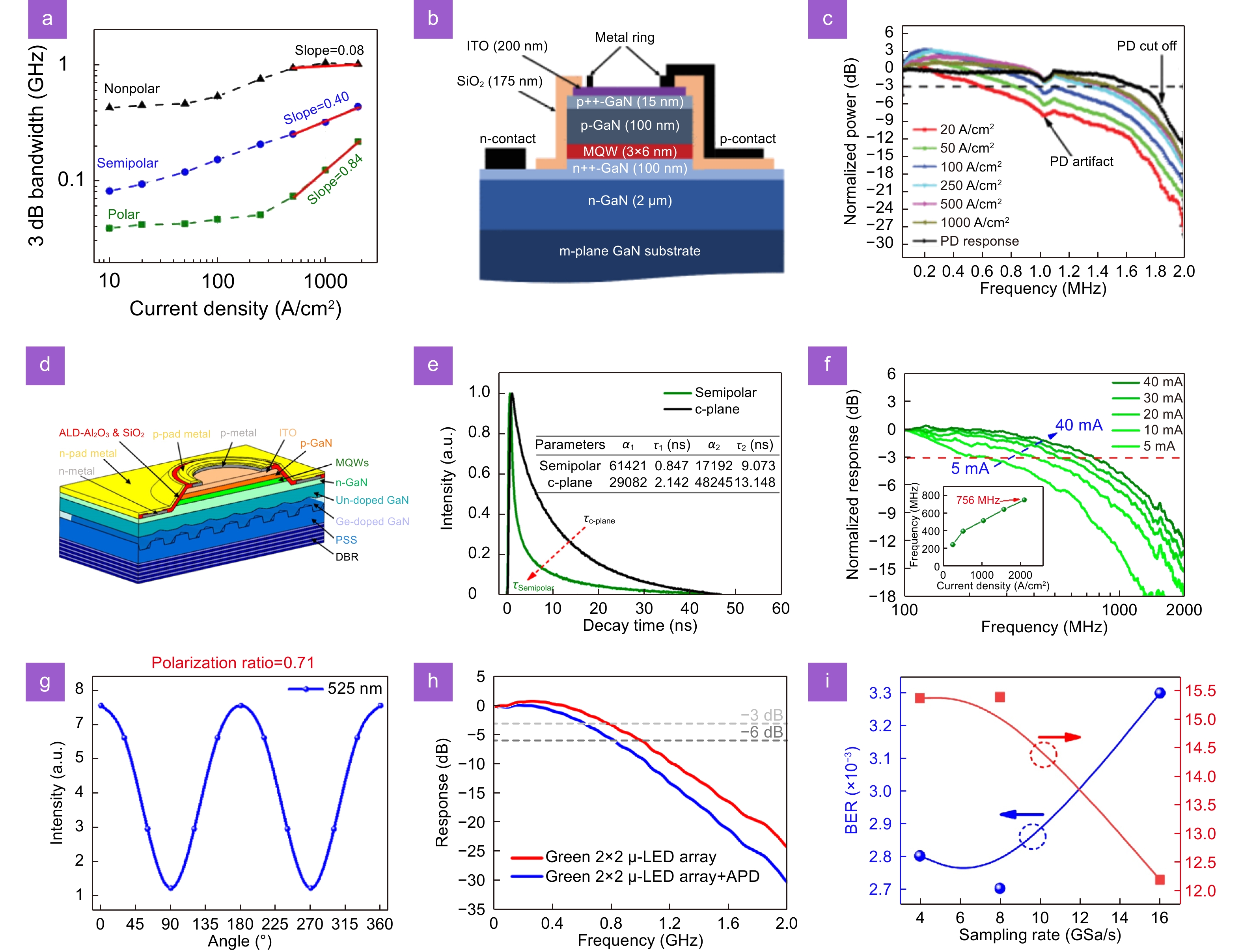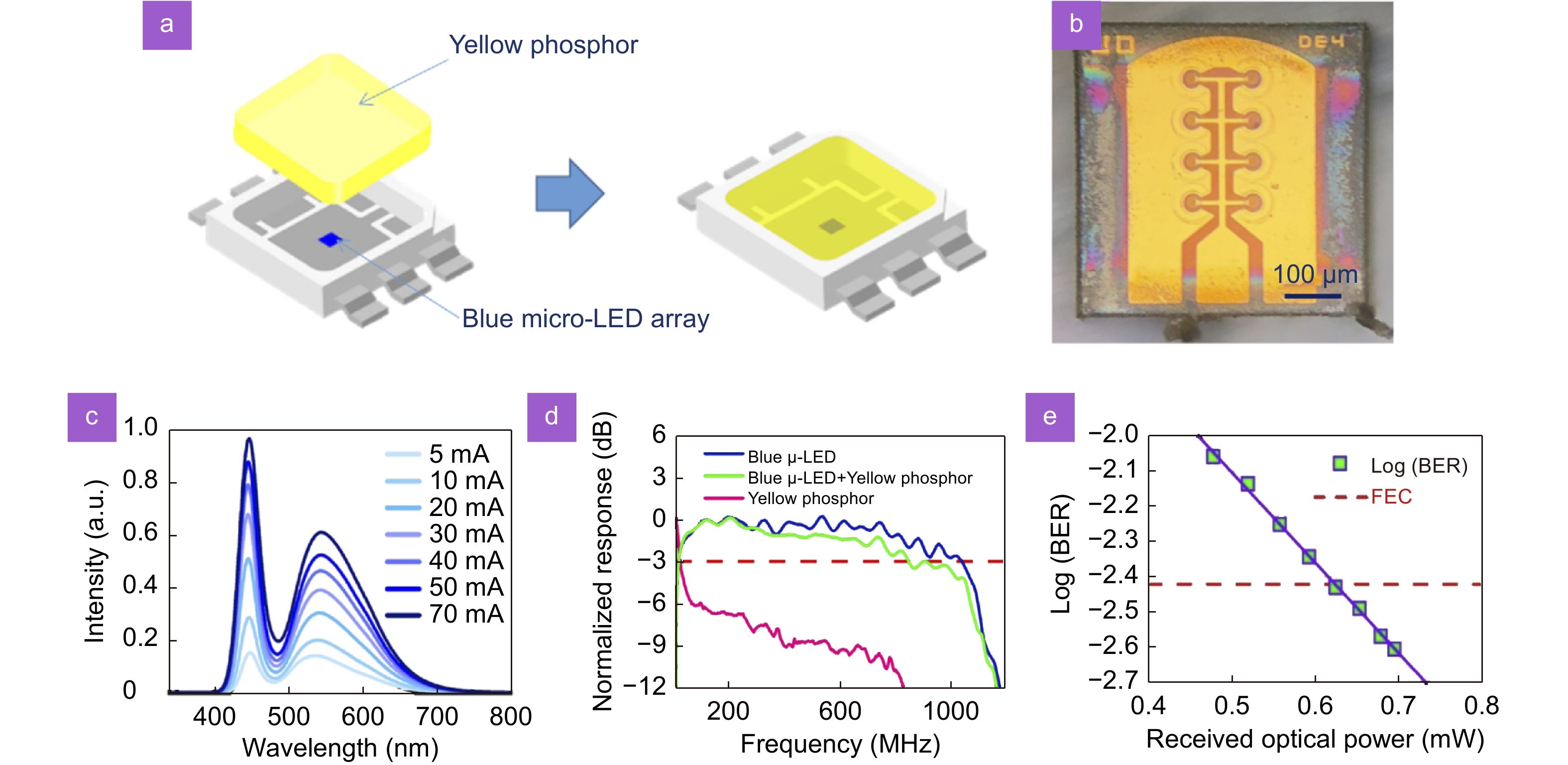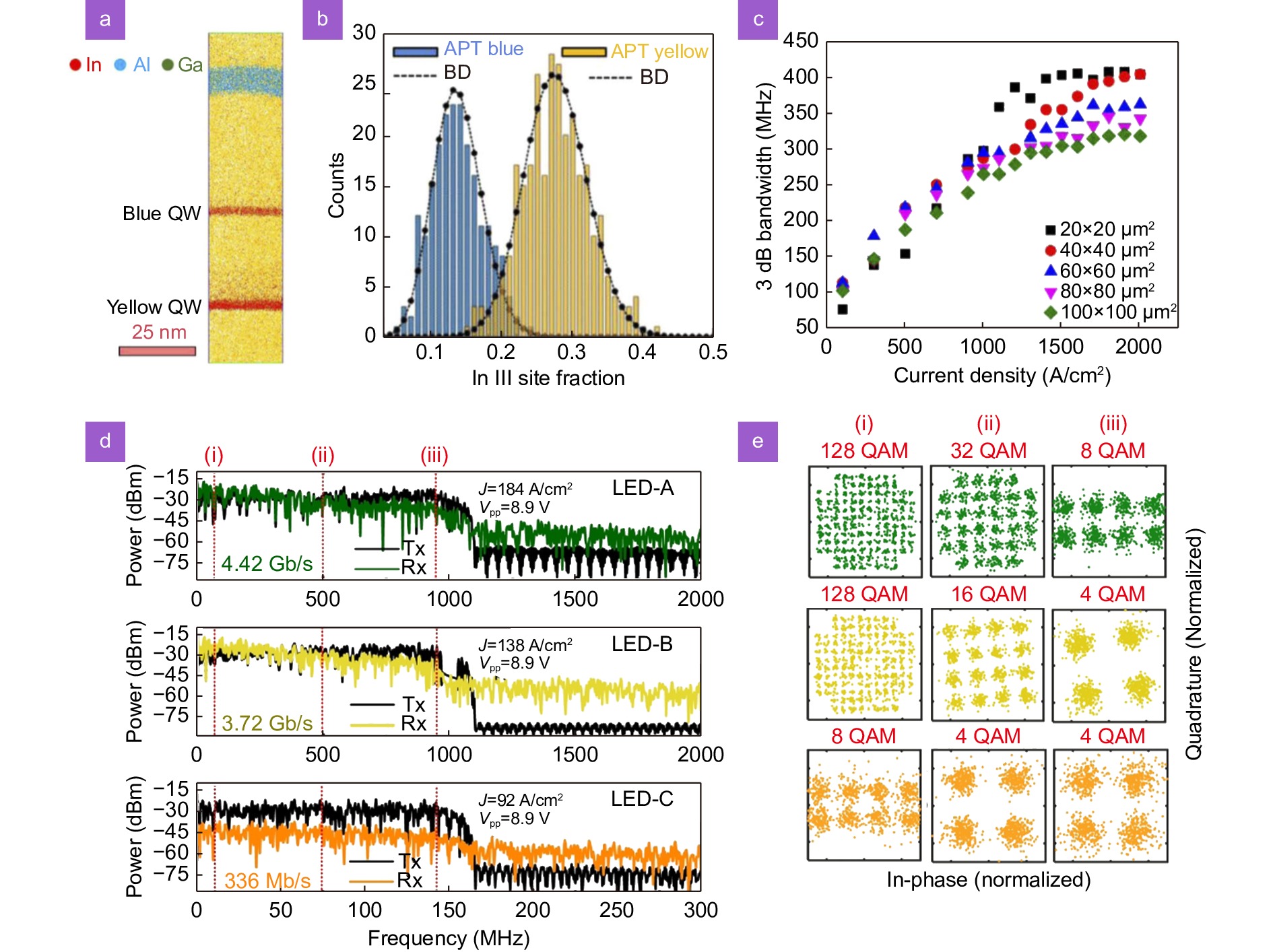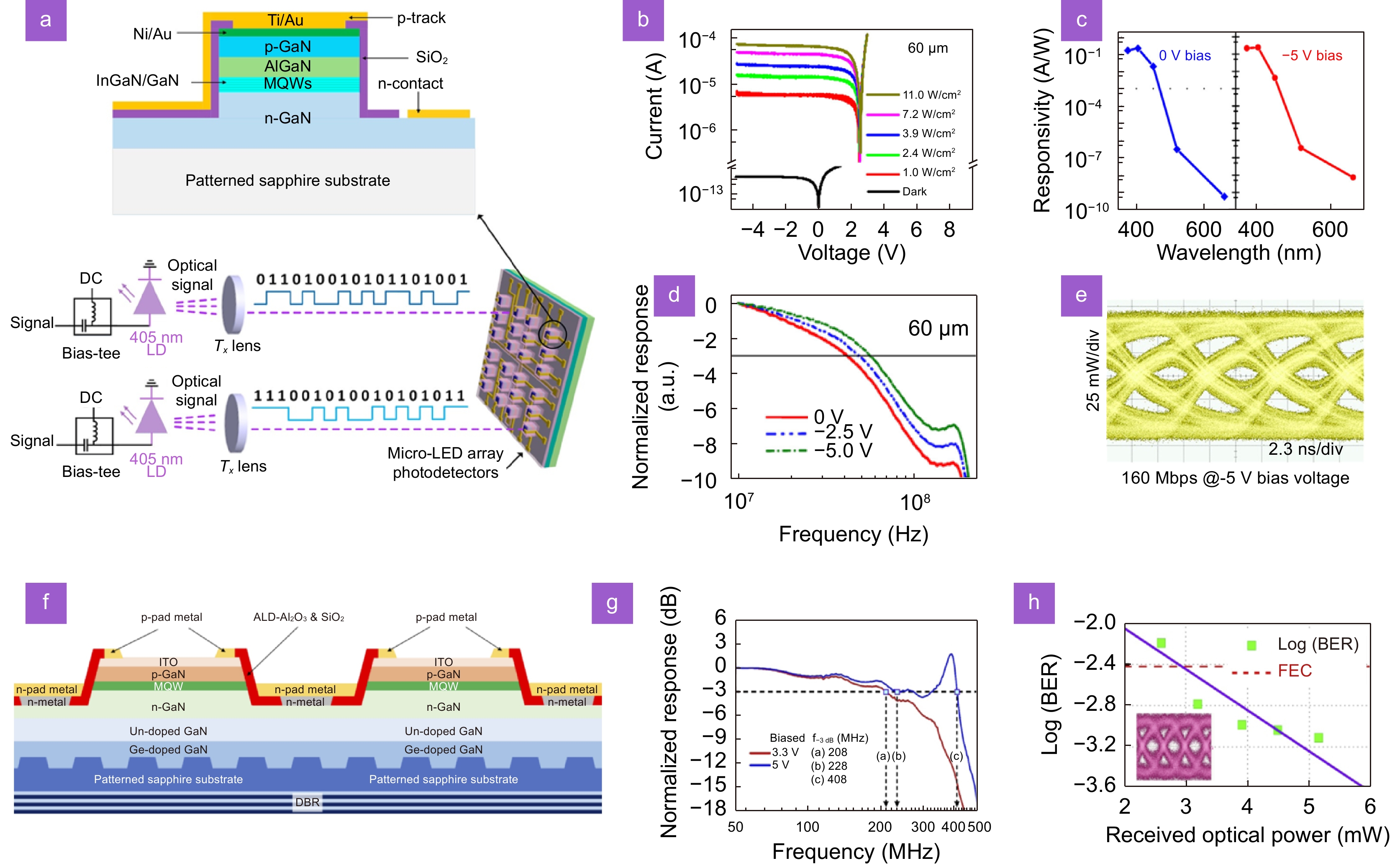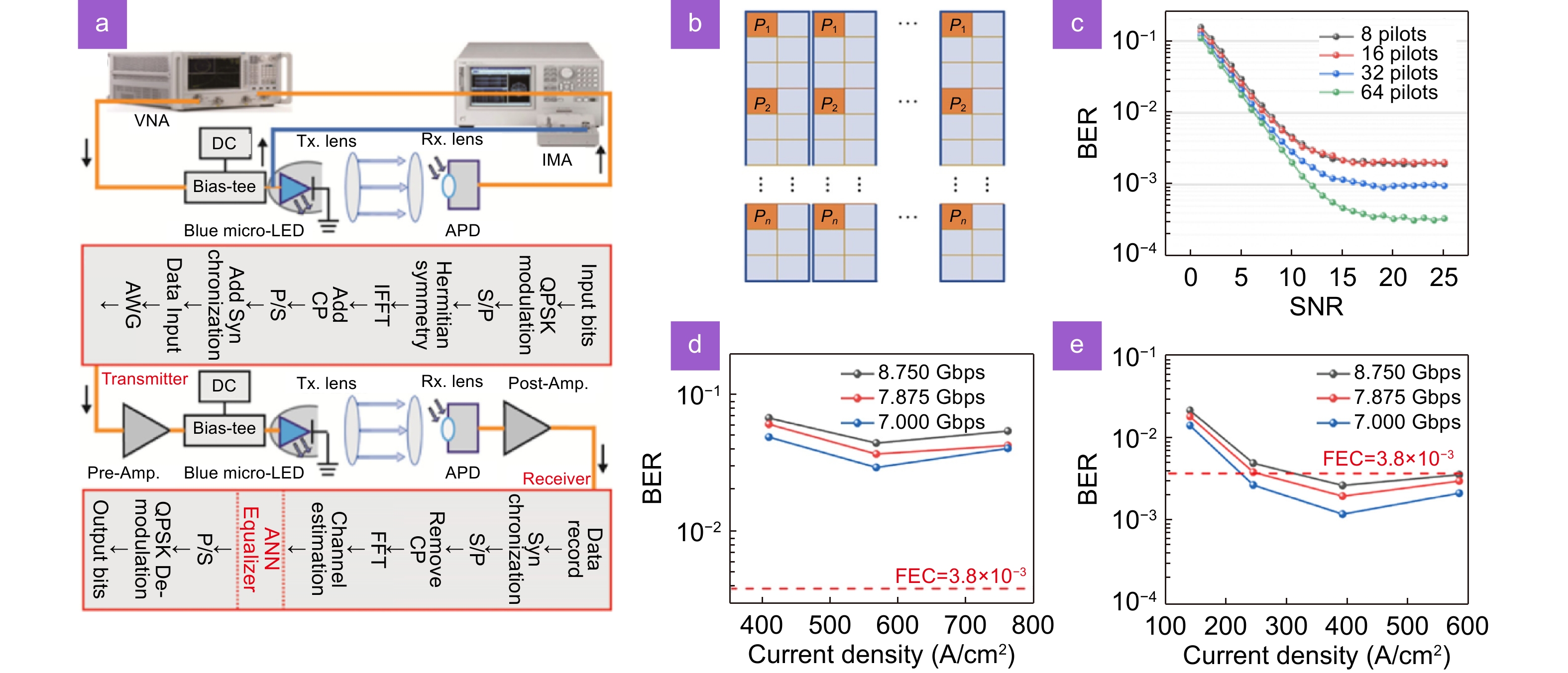| Citation: | Lu TW, Lin XS, Guo QA, Tu CC, Liu SB et al. High-speed visible light communication based on micro-LED: A technology with wide applications in next generation communication. Opto-Electron Sci 1, 220020 (2022). doi: 10.29026/oes.2022.220020 |
High-speed visible light communication based on micro-LED: A technology with wide applications in next generation communication
-
Abstract
The evolution of next-generation cellular networks is aimed at creating faster, more reliable solutions. Both the next-generation 6G network and the metaverse require high transmission speeds. Visible light communication (VLC) is deemed an important ancillary technology to wireless communication. It has shown potential for a wide range of applications in next-generation communication. Micro light-emitting diodes (μLEDs) are ideal light sources for high-speed VLC, owing to their high modulation bandwidths. In this review, an overview of μLEDs for VLC is presented. Methods to improve the modulation bandwidth are discussed in terms of epitaxy optimization, crystal orientation, and active region structure. Moreover, electroluminescent white LEDs, photoluminescent white LEDs based on phosphor or quantum-dot color conversion, and μLED-based detectors for VLC are introduced. Finally, the latest high-speed VLC applications and the application prospects of VLC in 6G are introduced, including underwater VLC and artificial intelligence-based VLC systems.-
Keywords:
- visible light communication /
- μLEDs /
- modulation bandwidth /
- detector /
- 6G
-

-
References
[1] Chow CW, Kuo FM, Shi JW, Yeh CH, Wu YF et al. 100 GHz ultra-wideband (UWB) fiber-to-the-antenna (FTTA) system for in-building and in-home networks. Opt Express 18, 473–478 (2010). doi: 10.1364/OE.18.000473 [2] Karunatilaka D, Zafar F, Kalavally V, Parthiban R. LED based indoor visible light communications: state of the art. IEEE Commun Surv Tutor 17, 1649–1678 (2015). doi: 10.1109/COMST.2015.2417576 [3] Hussain B, Li XB, Che FY, Yue CP, Wu L. Visible light communication system design and link budget analysis. J Lightwave Technol 33, 5201–5209 (2015). doi: 10.1109/JLT.2015.2499204 [4] Zhang CY, Zhou W, Geng D, Bai C, Li WD et al. Laser direct writing and characterizations of flexible piezoresistive sensors with microstructures. Opto-Electron Adv 4, 200061 (2021). doi: 10.29026/oea.2021.200061 [5] Yu KP, Tan L, Yang CX, Choo KKR, Bashir AK et al. A blockchain-based shamir's threshold cryptography scheme for data protection in industrial internet of things settings. IEEE Internet Things J 9, 8154–8167 (2022). doi: 10.1109/JIOT.2021.3125190 [6] Zhang JM, Harman M, Ma L, Liu Y. Machine learning testing: survey, landscapes and horizons. IEEE Trans Softw Eng 48, 1–36 (2022). [7] Ahn SJ, Kim J, Kim J. The bifold triadic relationships framework: a theoretical primer for advertising research in the metaverse. J Advert 51, 592–607 (2022). doi: 10.1080/00913367.2022.2111729 [8] Kwon HJ, El Azzaoui A, Park JH. MetaQ: a quantum approach for secure and qptimized metaverse environment. Human-Centric Comput Inf Sci 12, 42 (2022). [9] Khan LU. Visible light communication: applications, architecture, standardization and research challenges. Digit Commun Netw 3, 78–88 (2017). doi: 10.1016/j.dcan.2016.07.004 [10] Xu B, Sanjurjo DA, Colombi D, Törnevik C. A monte carlo analysis of actual maximum exposure from a 5G millimeter-wave base station antenna for EMF compliance assessments. Front Public Health 9, 777759 (2022). doi: 10.3389/fpubh.2021.777759 [11] Li X, Tang H, Hu GB, Zhao B, Liang JR. ViPSN-Pluck: a transient-motion-powered motion detector. IEEE Internet Things J 9, 3372–3382 (2022). doi: 10.1109/JIOT.2021.3098238 [12] Lee JH, Islam ABMH, Kim TK, Cha YJ, Kwak JS. Impact of tin-oxide nanoparticles on improving the carrier transport in the Ag/p-GaN interface of InGaN/GaN micro-light-emitting diodes by originating inhomogeneous Schottky barrier height. Photonics Res 8, 1049–1058 (2020). doi: 10.1364/PRJ.385249 [13] Lee DH, Seong TY, Amano H. Stable electrical performance of AlGaInP-based red micro-light emitting diode by controlling interfacial morphologies of metal contacts. J Alloys Compd 872, 159629 (2021). doi: 10.1016/j.jallcom.2021.159629 [14] Haigh PA, Ghassemlooy Z, Rajbhandari S, Papakonstantinou I. Visible light communications using organic light emitting diodes. IEEE Commun Mag 51, 148–154 (2013). [15] Sajjad MT, Manousiadis PP, Chun H, Vithanage DA, Rajbhandari S et al. Novel fast color-converter for visible light communication using a blend of conjugated polymers. ACS Photonics 2, 194–199 (2015). doi: 10.1021/ph500451y [16] Zhang SY, Tsonev D, Videv S, Ghosh S, Turnbull GA et al. Organic solar cells as high-speed data detectors for visible light communication. Optica 2, 607–610 (2015). doi: 10.1364/OPTICA.2.000607 [17] Lu XY, Zhu SJ, Lin RZ, Sun D, Cui XG et al. Performance improvement of red InGaN micro-LEDs by transfer printing from Si substrate onto glass substrate. IEEE Electron Device Lett 43, 1491–1494 (2022). doi: 10.1109/LED.2022.3189443 [18] Fan XT, Wu TZ, Liu B, Zhang R, Kuo HC et al. Recent developments of quantum dot based micro-LED based on non-radiative energy transfer mechanism. Opto-Electron Adv 4, 210022 (2021). doi: 10.29026/oea.2021.210022 [19] Du CH, Jiang CY, Zuo P, Huang X, Pu X et al. Piezo-phototronic effect controlled dual-channel visible light communication (PVLC) using InGaN/GaN multiquantum well nanopillars. Small 11, 6071–6077 (2015). doi: 10.1002/smll.201502170 [20] Elgala H, Mesleh R, Haas H. Indoor optical wireless communication: potential and state-of-the-art. IEEE Commun Mag 49, 56–62 (2011). [21] Pathak PH, Feng XT, Hu PF, Mohapatra P. Visible light communication, networking, and sensing: a survey, potential and challenges. IEEE Commun Surv Tutor 17, 2047–2077 (2015). doi: 10.1109/COMST.2015.2476474 [22] Parikh H, Chokshi J, Gala N, Biradar T. Wirelessly transmitting a grayscale image using visible light. In Proceedings of 2013 International Conference on Advances in Technology and Engineering (ICATE) 1–6 (IEEE, 2013);http://doi.org/10.1109/ICAdTE.2013.6524748 [23] Dede G, Kamalakis T, Varoutas D. Evaluation of optical wireless technologies in home networking: an analytical hierarchy process approach. J Opt Commun Netw 3, 850–859 (2011). doi: 10.1364/JOCN.3.000850 [24] Zhang YL, Jiang MJ, Han T, Xiao XT, Chen WL et al. Aggregation-induced emission luminogens as color converters for visible-light communication. ACS Appl Mater Interfaces 10, 34418–34426 (2018). doi: 10.1021/acsami.8b05950 [25] Zhou ZJ, Tian PF, Liu XY, Mei SL, Zhou D et al. Hydrogen peroxide-treated carbon dot phosphor with a bathochromic-shifted, aggregation-enhanced emission for light-emitting devices and visible light communication. Adv Sci 5, 1800369 (2018). doi: 10.1002/advs.201800369 [26] Khonina SN, Kazanskiy NL, Butt MA, Karpeev SV. Optical multiplexing techniques and their marriage for on-chip and optical fiber communication: a review. Opto-Electron Adv 5, 210127 (2022). doi: 10.29026/oea.2022.210127 [27] Jovicic A, Li JY, Richardson T. Visible light communication: opportunities, challenges and the path to market. IEEE Commun Mag 51, 26–32 (2013). [28] O'Brien DC. Visible light communications: challenges and potential. In Proceedings of the IEEE Photonic Society 24th Annual Meeting 365–366 (IEEE, 2011);http://doi.org/10.1109/PHO.2011.6110579. [29] McKendry JJD, Massoubre D, Zhang SL, Rae BR, Green RP et al. Visible-light communications using a CMOS-controlled micro-light-emitting-diode array. J Lightwave Technol 30, 61–67 (2012). doi: 10.1109/JLT.2011.2175090 [30] Zhang SL, Watson S, McKendry JJD, Massoubre D, Cogman A et al. 1.5 Gbit/s multi-channel visible light communications using CMOS-controlled GaN-based LEDs. J Lightwave Technol 31, 1211–1216 (2013). doi: 10.1109/JLT.2013.2246138 [31] Huang YM, Peng CY, Miao WC, Chiang H, Lee TY et al. High-efficiency InGaN red micro-LEDs for visible light communication. Photonics Res 10, 1978–1986 (2022). doi: 10.1364/PRJ.462050 [32] Biagi M, Borogovac T, Little TDC. Adaptive receiver for indoor visible light communications. J Lightwave Technol 31, 3676–3686 (2013). doi: 10.1109/JLT.2013.2287051 [33] Zhu SC, Yu ZG, Zhao LX, Wang JX, Li JM. Enhancement of the modulation bandwidth for GaN-based light-emitting diode by surface plasmons. Opt Express 23, 13752–13760 (2015). doi: 10.1364/OE.23.013752 [34] Zhao L, Cai KY, Jiang M. Multiuser precoded MIMO visible light communication systems enabling spatial dimming. J Lightwave Technol 38, 5624–5634 (2020). doi: 10.1109/JLT.2020.3003857 [35] Wu HJ, Wang Q, Xiong J, Zuniga M. SmartVLC: co-designing smart lighting and communication for visible light networks. IEEE Trans Mob Comput 19, 1956–1970 (2020). doi: 10.1109/TMC.2019.2915220 [36] Dursun I, Shen C, Parida MR, Pan J, Sarmah SP et al. Perovskite nanocrystals as a color converter for visible light communication. ACS Photonics 3, 1150–1156 (2016). doi: 10.1021/acsphotonics.6b00187 [37] Gao H, Xie YY, Geng C, Xu S, Bi WG. Efficiency enhancement of quantum-dot-converted LEDs by 0D-2D hybrid scatterers. ACS Photonics 7, 3430–3439 (2020). doi: 10.1021/acsphotonics.0c01240 [38] Lai SQ, Li QX, Long H, Ying LY, Zheng ZW et al. Theoretical study and optimization of the green InGaN/GaN multiple quantum wells with pre-layer. Superlattices Microstruct 155, 106906 (2021). doi: 10.1016/j.spmi.2021.106906 [39] Yan DD, Zhao SY, Zhang YB, Wang HX, Zang ZG. Highly efficient emission and high-CRI warm white light-emitting diodes from ligand-modified CsPbBr3 quantum dots. Opto-Electron Adv 5, 200075 (2022). doi: 10.29026/oea.2022.200075 [40] Su CY, Wu YC, Cheng CH, Wang WC, Wang HY et al. Color-converting violet laser diode with an ultrafast BEHP-PPV + MEH-PPV polymer blend for high-speed white lighting data link. ACS Appl Electron Mater 2, 3017–3027 (2020). doi: 10.1021/acsaelm.0c00619 [41] Shi JW, Sheu JK, Chen CH, Lin GR, Lai WC. High-speed GaN-based green light-emitting diodes with partially n-doped active layers and current-confined apertures. IEEE Electron Device Lett 29, 158–160 (2008). doi: 10.1109/LED.2007.914070 [42] Ryou JH, Lee W, Limb J, Yoo D, Liu JP et al. Control of quantum-confined Stark effect in InGaN/GaN multiple quantum well active region by p-type layer for III-nitride-based visible light emitting diodes. Appl Phys Lett 92, 101113 (2008). doi: 10.1063/1.2894514 [43] Chen XW, Jin MY, Lin RZ, Zhou GF, Cui XG et al. Visible light communication based on computational temporal ghost imaging and micro-LED-based detector. Opt Lasers Eng 152, 106956 (2022). doi: 10.1016/j.optlaseng.2022.106956 [44] Wang YP, Chen HL, Jiang WJ, Li XY, Chen XW et al. Optical encryption for visible light communication based on temporal ghost imaging with a micro-LED. Opt Lasers Eng 134, 106290 (2020). doi: 10.1016/j.optlaseng.2020.106290 [45] Islim MS, Ferreira RX, He XY, Xie EY, Videv S et al. Towards 10 Gb/s orthogonal frequency division multiplexing-based visible light communication using a GaN violet micro-LED. Photonics Res 5, A35–A43 (2017). doi: 10.1364/PRJ.5.000A35 [46] Zhu SJ, Qiu PJ, Shan XY, Lin RZ, Wang Z et al. High-speed long-distance visible light communication based on multicolor series connection micro-LEDs and wavelength division multiplexing. Photonics Res 10, 1892–1899 (2022). doi: 10.1364/PRJ.459531 [47] Asad M, Li Q, Sachdev M, Wong WS. Thermal and optical properties of high-density GaN micro-LED arrays on flexible substrates. Nano Energy 73, 104724 (2020). doi: 10.1016/j.nanoen.2020.104724 [48] Lai SQ, Lu TW, Lin SH, Lin Y, Lin GC et al. Improved modulation bandwidth of blue mini-LEDs by atomic-layer deposition sidewall passivation. IEEE Trans Electron Devices 69, 4936–4943 (2022). doi: 10.1109/TED.2022.3188738 [49] Zhou GF, Lin RZ, Qian ZY, Zhou XJ, Shan XY et al. GaN-based micro-LEDs and detectors defined by current spreading layer: size-dependent characteristics and their multifunctional applications. J Phys D Appl Phys 54, 335104 (2021). doi: 10.1088/1361-6463/abfef9 [50] Katz M, Ahmed I. Opportunities and challenges for visible light communications in 6G. In Proceedings of the 2nd 6G Wireless Summit (6G SUMMIT) 1–5 (IEEE, 2020);http://doi.org/10.1109/6GSUMMIT49458.2020.9083805. [51] Saud MS, Ahmed I, Kumpuniemi T, Katz M. Reconfigurable optical-radio wireless networks: meeting the most stringent requirements of future communication systems. Trans Emerg Telecommun Technol 30, e3562 (2019). doi: 10.1002/ett.3562 [52] Chi N, Haas H, Kavehrad M, Little TDC, Huang XL. Visible light communications: demand factors, benefits and opportunities [Guest Editorial]. IEEE Wirel Commun 22, 5–7 (2015). [53] Li JH, Wang FM, Zhao MM, Jiang FY, Chi N. Large-coverage underwater visible light communication system based on blue LED employing equal gain combining with integrated PIN array reception. Appl Opt 58, 383–388 (2019). doi: 10.1364/AO.58.000383 [54] Chen M, Zou P, Zhang L, Chi N. Demonstration of a 2.34 Gbit/s real-time single silicon-substrate blue LED-based underwater VLC system. IEEE Photonics J 12, 7900211 (2020). [55] Zou P, Zhao YH, Hu FC, Chi N. Enhanced performance of MIMO multi-branch hybrid neural network in single receiver MIMO visible light communication system. Opt Express 28, 28017–28032 (2020). doi: 10.1364/OE.400825 [56] Wu SE, Wang HG, Youn CH. Visible light communications for 5G wireless networking systems: from fixed to mobile communications. IEEE Netw 28, 41–45 (2014). doi: 10.1109/MNET.2014.6963803 [57] Arfaoui MA, Soltani MD, Tavakkolnia I, Ghrayeb A, Assi CM et al. Measurements-based channel models for indoor lifi systems. IEEE Trans Wirel Commun 20, 827–842 (2021). doi: 10.1109/TWC.2020.3028456 [58] Haemmer M, Roycroft B, Akhter M, Dinh DV, Quan Z et al. Size-dependent bandwidth of semipolar ( $ 11 \overline{2} 2 $ ) light-emitting-diodes. IEEE Photonics Technol Lett 30, 439–442 (2018).CrossRef $ 11 \overline{2} 2 $
[59] Mickevičius J, Tamulaitis G, Kuokštis E, Liu K, Shur MS et al. Well-width-dependent carrier lifetime in AlGaN/AlGaN quantum wells. Appl Phys Lett 90, 131907 (2007). doi: 10.1063/1.2717145 [60] Li YL, Huang YR, Lai YH. Efficiency droop behaviors of InGaN/GaN multiple-quantum-well light-emitting diodes with varying quantum well thickness. Appl Phys Lett 91, 181113 (2007). doi: 10.1063/1.2805197 [61] Tian PF, McKendry JJD, Gong Z, Guilhabert B, Watson IM et al. Size-dependent efficiency and efficiency droop of blue InGaN micro-light emitting diodes. Appl Phys Lett 101, 231110 (2012). doi: 10.1063/1.4769835 [62] Kim H, Cho J, Lee JW, Yoon S, Kim H et al. Measurements of current spreading length and design of GaN-based light emitting diodes. Appl Phys Lett 90, 063510 (2007). doi: 10.1063/1.2450670 [63] Ryu HY, Shim JI. Effect of current spreading on the efficiency droop of InGaN light-emitting diodes. Opt Express 19, 2886–2894 (2011). doi: 10.1364/OE.19.002886 [64] Gong Z, Jin SR, Chen YJ, McKendry J, Massoubre D et al. Size-dependent light output, spectral shift, and self-heating of 400 nm InGaN light-emitting diodes. J Appl Phys 107, 013103 (2010). doi: 10.1063/1.3276156 [65] Monavarian M, Rashidi A, Aragon AA, Oh SH, Rishinaramangalam AK et al. Impact of crystal orientation on the modulation bandwidth of InGaN/GaN light-emitting diodes. Appl Phys Lett 112, 041104 (2018). doi: 10.1063/1.5019730 [66] Piprek J. Efficiency droop in nitride-based light-emitting diodes. Phys Status Solidi 207, 2217–2225 (2010). [67] Bernardini F, Fiorentini V, Vanderbilt D. Spontaneous polarization and piezoelectric constants of III-V nitrides. Phys Rev B 56, R10024–R10027 (1997). doi: 10.1103/PhysRevB.56.R10024 [68] Takeuchi T, Sota S, Katsuragawa M, Komori M, Takeuchi H et al. Quantum-confined stark effect due to piezoelectric fields in GaInN strained quantum wells. Jpn J Appl Phys 36, L382–L385 (1997). doi: 10.1143/JJAP.36.L382 [69] Du CH, Huang X, Jiang CY, Pu X, Zhao ZF et al. Tuning carrier lifetime in InGaN/GaN LEDs via strain compensation for high-speed visible light communication. Sci Rep 6, 37132 (2016). doi: 10.1038/srep37132 [70] Rajabi K, Wang JX, Jin J, Xing YC, Wang L et al. Improving modulation bandwidth of c-plane GaN-based light-emitting diodes by an ultra-thin quantum wells design. Opt Express 26, 24985–24991 (2018). doi: 10.1364/OE.26.024985 [71] Lin GB, Kim DY, Shan QF, Cho J, Schubert EF et al. Effect of quantum barrier thickness in the multiple-quantum-well active region of gainn/gan light-emitting diodes. IEEE Photonics J 5, 1600207 (2013). doi: 10.1109/JPHOT.2013.2276758 [72] Wang CK, Chiou YZ, Chang SJ, Chang CY, Chiang TH et al. On the effect of quantum barrier thickness in the active region of nitride-based light emitting diodes. Solid·State Electron 99, 11–15 (2014). [73] Hammersley S, Watson-Parris D, Dawson P, Godfrey MJ, Badcock TJ et al. The consequences of high injected carrier densities on carrier localization and efficiency droop in InGaN/GaN quantum well structures. J Appl Phys 111, 083512 (2012). doi: 10.1063/1.3703062 [74] Bochkareva NI, Rebane YT, Shreter YG. Efficiency droop and incomplete carrier localization in InGaN/GaN quantum well light-emitting diodes. Appl Phys Lett 103, 191101 (2013). doi: 10.1063/1.4828780 [75] Malinauskas T, Miasojedovas S, Aleksiejūnas R, Juršėnas S, Jarašiūnas K et al. Direct study of nonlinear carrier recombination in InGaN quantum well structures. Phys Status Solidi 8, 2381–2383 (2011). [76] Zhu SC, Lin S, Li J, Yu ZG, Cao HC et al. Influence of quantum confined Stark effect and carrier localization effect on modulation bandwidth for GaN-based LEDs. Appl Phys Lett 111, 171105 (2017). doi: 10.1063/1.4993230 [77] Li Z, Kang JJ, Wang BW, Li HJ, Weng YH et al. Two distinct carrier localization in green light-emitting diodes with InGaN/GaN multiple quantum wells. J Appl Phys 115, 083112 (2014). doi: 10.1063/1.4866815 [78] Bai J, Cai YF, Feng P, Fletcher P, Zhao XM et al. A direct epitaxial approach to achieving ultrasmall and ultrabright InGaN micro light-emitting diodes (μLEDs). ACS Photonics 7, 411–415 (2020). doi: 10.1021/acsphotonics.9b01351 [79] Chung KC, Lee JJ, Huang JR, Lai YJ, Chen KH et al. A dynamic compensated and 95% high-efficiency supply buffer in RGB virtual pixel microLED display for reducing ghosting by 73% and achieving four times screen resolution. IEEE Trans Power Electron 36, 8291–8299 (2021). doi: 10.1109/TPEL.2020.3047372 [80] Bai J, Cai YF, Feng P, Fletcher P, Zhu CQ et al. Ultrasmall, ultracompact and ultrahigh efficient InGaN micro light emitting diodes (μLEDs) with narrow spectral line width. ACS Nano 14, 6906–6911 (2020). doi: 10.1021/acsnano.0c01180 [81] Yang W, Zhang SL, McKendry JJD, Herrnsdorf J, Tian PF et al. Size-dependent capacitance study on InGaN-based micro-light-emitting diodes. J Appl Phys 116, 044512 (2014). doi: 10.1063/1.4891233 [82] Tang ZK, Jiang QM, Lu YY, Huang S, Yang S et al. 600-V normally off SiNx/AlGaN/GaN MIS-HEMT with large gate swing and low current collapse. IEEE Electron Device Lett 34, 1373–1375 (2013). doi: 10.1109/LED.2013.2279846 [83] Wong MS, Hwang D, Alhassan AI, Lee C, Ley R et al. High efficiency of III-nitride micro-light-emitting diodes by sidewall passivation using atomic layer deposition. Opt Express 26, 21324–21331 (2018). doi: 10.1364/OE.26.021324 [84] Huang SC, Li H, Zhang ZH, Chen H, Wang SC et al. Superior characteristics of microscale light emitting diodes through tightly lateral oxide-confined scheme. Appl Phys Lett 110, 021108 (2017). doi: 10.1063/1.4973966 [85] Smith JM, Ley R, Wong MS, Baek YH, Kang JH et al. Comparison of size-dependent characteristics of blue and green InGaN microLEDs down to 1μm in diameter. Appl Phys Lett 116, 071102 (2020). doi: 10.1063/1.5144819 [86] Lin RZ, Jin ZX, Qiu PJ, Liao Y, Hoo J et al. High bandwidth series-biased green micro-LED array toward 6 Gbps visible light communication. Opt Lett 47, 3343–3346 (2022). doi: 10.1364/OL.458495 [87] Chang YH, Huang YM, Liou FJ, Chow CW, Liu Y et al. 2.805 Gbit/s high-bandwidth phosphor white light visible light communication utilizing an InGaN/GaN semipolar blue micro-LED. Opt Express 30, 16938–16946 (2022). doi: 10.1364/OE.455312 [88] Zhang Y, Wei ZX, Wang ZM, Fu HY. Real-time receive-forward NLOS visible light communication system based on multiple blue micro-LED nodes. Photonics 9, 211 (2022). doi: 10.3390/photonics9040211 [89] Zhu SJ, Shan XY, Qiu PJ, Wang Z, Yuan ZX et al. Low-power high-bandwidth non-polar InGaN micro-LEDs at low current densities for energy-efficient visible light communication. IEEE Photonics J 14, 7351805 (2022). [90] Xu FF, Jin ZX, Tao T, Tian PF, Wang GB et al. C-plane blue micro-LED with 1.53 GHz bandwidth for high-speed visible light communication. IEEE Electron Device Lett 43, 910–913 (2022). doi: 10.1109/LED.2022.3168314 [91] Wei ZX, Wang L, Liu ZX, Zhang C, Chen CJ et al. Multigigabit visible light communication based on high-bandwidth InGaN quantum dot green micro-LED. ACS Photonics 9, 2354–2366 (2022). doi: 10.1021/acsphotonics.2c00380 [92] Chang YH, Huang YM, Gunawan WH, Chang GH, Liou FJ et al. 4.343-Gbit/s green semipolar (20–21) μ-LED for high speed visible light communication. IEEE Photonics J 13, 7300204 (2021). [93] Wang L, Wang L, Chen CJ, Chen KC, Hao ZB et al. Green InGaN quantum dots breaking through efficiency and bandwidth bottlenecks of micro-LEDs. Laser Photon. Rev 15, 2000406 (2021). doi: 10.1002/lpor.202000406 [94] Lin RZ, Liu XY, Zhou GF, Qian ZY, Cui XG et al. InGaN micro-LED array enabled advanced underwater wireless optical communication and underwater charging. Adv Opt Mater 9, 2002211 (2021). doi: 10.1002/adom.202002211 [95] Wang L, Wei ZX, Chen CJ, Wang L, Fu HY et al. 1.3 GHz E-O bandwidth GaN-based micro-LED for multi-gigabit visible light communication. Photonics Res 9, 792–802 (2021). doi: 10.1364/PRJ.411863 [96] Chen SWH, Huang YM, Chang YH, Lin Y, Liou FJ et al. High-bandwidth green semipolar (20–21) InGaN/GaN micro light-emitting diodes for visible light communication. ACS Photonics 7, 2228–2235 (2020). doi: 10.1021/acsphotonics.0c00764 [97] Lan HY, Tseng IC, Kao HY, Lin YH, Lin GR et al. 752-MHz modulation bandwidth of high-speed blue micro light-emitting diodes. IEEE J Quantum Electron 54, 3300106 (2018). [98] Ferreira RXG, Xie EY, McKendry JJD, Rajbhandari S, Chun H et al. High bandwidth GaN-based micro-LEDs for multi-Gb/s visible light communications. IEEE Photonics Technol Lett 28, 2023–2026 (2016). doi: 10.1109/LPT.2016.2581318 [99] Ma ZH, Cao HC, Lin S, Li XD, Xi X et al. Optical and frequency degradation behavior of GaN-based micro-LEDs for visible light communication. Opt Express 28, 12795–12804 (2020). doi: 10.1364/OE.383867 [100] Cai YF, Haggar JIH, Zhu CQ, Feng P, Bai J et al. Direct epitaxial approach to achieve a monolithic on-chip integration of a HEMT and a single micro-LED with a high-modulation bandwidth. ACS Appl Electron Mater 3, 445–450 (2021). doi: 10.1021/acsaelm.0c00985 [101] Zhao YJ, Fu HQ, Wang GT, Nakamura S. Toward ultimate efficiency: progress and prospects on planar and 3D nanostructured nonpolar and semipolar InGaN light-emitting diodes. Adv Opt Photon 10, 246–308 (2018). doi: 10.1364/AOP.10.000246 [102] Rosales D, Gil B, Bretagnon T, Guizal B, Zhang F et al. Excitonic recombination dynamics in non-polar GaN/AlGaN quantum wells. J Appl Phys 115, 073510 (2014). doi: 10.1063/1.4865959 [103] Rashidi A, Monavarian M, Aragon A, Rishinaramangalam A, Feezell D. Nonpolar m-plane InGaN/GaN micro-scale light-emitting diode with 1.5 GHz modulation bandwidth. IEEE Electron Device Lett 39, 520–523 (2018). doi: 10.1109/LED.2018.2803082 [104] Johar MA, Song HG, Waseem A, Kang JH, Ha JS et al. Ultrafast carrier dynamics of conformally grown semi-polar ( $ 11 {\bar {2}} 2 $ ) GaN/InGaN multiple quantum well co-axial nanowires on m-axial GaN core nanowires. Nanoscale 11, 10932–10943 (2019).CrossRef $ 11 {\bar {2}} 2 $
[105] Fu HQ, Lu ZJ, Zhao XH, Zhang YH, DenBaars SP et al. Study of low-efficiency droop in semipolar ( $ 20 \overline{2} \overline{1} $ ) InGaN light-emitting diodes by time-resolved photoluminescence. J Disp Technol 12, 736–741 (2016).CrossRef $ 20 \overline{2} \overline{1} $
[106] Chen SWH, Shen CC, Wu TZ, Liao ZY, Chen LF et al. Full-color monolithic hybrid quantum dot nanoring micro light-emitting diodes with improved efficiency using atomic layer deposition and nonradiative resonant energy transfer. Photonics Res 7, 416–422 (2019). doi: 10.1364/PRJ.7.000416 [107] Haggar JIH, Ghataora SS, Trinito V, Bai J, Wang T. Study of the luminescence decay of a semipolar green light-emitting diode for visible light communications by time-resolved electroluminescence. ACS Photonics 9, 2378–2384 (2022). doi: 10.1021/acsphotonics.2c00414 [108] Choi HW, Liu C, Gu E, McConnell G, Girkin JM et al. GaN micro-light-emitting diode arrays with monolithically integrated sapphire microlenses. Appl Phys Lett 84, 2253–2255 (2004). doi: 10.1063/1.1690876 [109] Lin GR, Kuo HC, Cheng CH, Wu YC, Huang YM et al. Ultrafast 2x2 green micro-LED array for optical wireless communication beyond 5 Gbit/s. Photonics Res 9, 2077–2087 (2021). doi: 10.1364/PRJ.437689 [110] Zhang HJ, Li PP, Li HJ, Song J, Nakamura S et al. High polarization and fast modulation speed of dual wavelengths electroluminescence from semipolar (20–21) micro light-emitting diodes with indium tin oxide surface grating. Appl Phys Lett 117, 181105 (2020). doi: 10.1063/5.0022412 [111] Gao HY, Yan FW, Zhang Y, Li JM, Zeng YP et al. Growth of nonpolar a-plane GaN on nano-patterned r-plane sapphire substrates. Appl Surf Sci 255, 3664–3668 (2009). doi: 10.1016/j.apsusc.2008.10.018 [112] Wang L, Wang L, Yu JD, Hao ZB, Luo Y et al. Abnormal stranski-krastanov mode growth of green InGaN quantum dots: morphology, optical properties, and applications in light-emitting devices. ACS Appl Mater Interfaces 11, 1228–1238 (2019). doi: 10.1021/acsami.8b16767 [113] Arita M, Le Roux F, Holmes MJ, Kako S, Arakawa Y. Ultraclean single photon emission from a GaN quantum dot. Nano Lett 17, 2902–2907 (2017). doi: 10.1021/acs.nanolett.7b00109 [114] Gačević Ž, Holmes M, Chernysheva E, Müeller M, Torres-Pardo A et al. Emission of linearly polarized single photons from quantum dots contained in nonpolar, semipolar, and polar sections of pencil-like InGaN/GaN nanowires. ACS Photonics 4, 657–664 (2017). doi: 10.1021/acsphotonics.6b01030 [115] Yang D, Wang L, Hao ZB, Luo Y, Sun CZ et al. Dislocation analysis of InGaN/GaN quantum dots grown by metal organic chemical vapor deposition. Superlattices Microstruct 99, 221–225 (2016). doi: 10.1016/j.spmi.2016.02.016 [116] Lv WB, Wang L, Wang JX, Xing YC, Zheng JY et al. Green and red light-emitting diodes based on multilayer InGaN/GaN dots grown by growth interruption method. Jpn J Appl Phys 52, 08JG13 (2013). doi: 10.7567/JJAP.52.08JG13 [117] Lv WB, Wang L, Wang L, Xing YC, Yang D et al. InGaN quantum dot green light-emitting diodes with negligible blue shift of electroluminescence peak wavelength. Appl Phys Express 7, 025203 (2014). doi: 10.7567/APEX.7.025203 [118] Wan RQ, Gao X, Wang LC, Zhang S, Chen XB et al. Phosphor-free single chip GaN-based white light emitting diodes with a moderate color rendering index and significantly enhanced communications bandwidth. Photonics Res 8, 1110–1117 (2020). doi: 10.1364/PRJ.392046 [119] Zhuang Z, Dai JP, Liu B, Guo X, Li Y et al. Improvement of color conversion and efficiency droop in hybrid light-emitting diodes utilizing an efficient non-radiative resonant energy transfer. Appl Phys Lett 109, 141105 (2016). doi: 10.1063/1.4964403 [120] Zhuang Z, Guo X, Liu B, Hu FR, Li Y et al. High color rendering index hybrid III-nitride/nanocrystals white light-emitting diodes. Adv Funct Mater 26, 36–43 (2016). doi: 10.1002/adfm.201502870 [121] Krishnan C, Brossard M, Lee KY, Huang JK, Lin CH et al. Hybrid photonic crystal light-emitting diode renders 123% color conversion effective quantum yield. Optica 3, 503–509 (2016). doi: 10.1364/OPTICA.3.000503 [122] Wan RQ, Li GQ, Gao X, Liu ZQ, Li JH et al. Nanohole array structured GaN-based white LEDs with improved modulation bandwidth via plasmon resonance and non-radiative energy transfer. Photonics Res 9, 1213–1217 (2021). doi: 10.1364/PRJ.421366 [123] Rishinaramangalam AK, Ul Masabih SM, Fairchild MN, Wright JB, Shima DM et al. Controlled growth of ordered III-Nitride core-shell nanostructure arrays for visible optoelectronic devices. J Electron Mater 44, 1255–1262 (2015). doi: 10.1007/s11664-014-3456-z [124] Tzou AJ, Hsieh DH, Hong KB, Lin DW, Huang JK et al. High-efficiency InGaN/GaN core-shell nanorod light-emitting diodes with low-peak blueshift and efficiency droop. IEEE Trans Nanotechnol 16, 355–358 (2017). doi: 10.1109/TNANO.2016.2642146 [125] Nami M, Rashidi A, Monavarian M, Mishkat-Ul-Masabih S, Rishinaramangalam AK et al. Electrically injected GHz-class GaN/InGaN core-nanowire-based μLEDs: carrier dynamics and nanoscale homogeneity. ACS Photonics 6, 1618–1625 (2019). doi: 10.1021/acsphotonics.9b00639 [126] Okamoto K, Niki I, Scherer A, Narukawa Y, Mukai T et al. Surface plasmon enhanced spontaneous emission rate of InGaN/GaN quantum wells probed by time-resolved photoluminescence spectroscopy. Appl Phys Lett 87, 071102 (2005). doi: 10.1063/1.2010602 [127] Gu XF, Qiu T, Zhang WJ, Chu PK. Light-emitting diodes enhanced by localized surface plasmon resonance. Nanoscale Res Lett 6, 199 (2011). doi: 10.1186/1556-276X-6-199 [128] Baets RG, Delbeke DG, Bockstaele R, Bienstman P. Resonant-cavity light-emitting diodes: a review. Proc SPIE 4996, 74–86 (2003). doi: 10.1117/12.476588 [129] Ferrari L, Smalley JST, Qian HL, Tanaka A, Lu D et al. Design and analysis of blue InGaN/GaN plasmonic LED for high-speed, high-efficiency optical communications. ACS Photonics 5, 3557–3564 (2018). doi: 10.1021/acsphotonics.8b00321 [130] Xiao XT, Tang HD, Zhang TQ, Chen W, Chen WL et al. Improving the modulation bandwidth of LED by CdSe/ZnS quantum dots for visible light communication. Opt Express 24, 21577–21586 (2016). doi: 10.1364/OE.24.021577 [131] Laurand N, Guilhabert B, McKendry J, Kelly AE, Rae B et al. Colloidal quantum dot nanocomposites for visible wavelength conversion of modulated optical signals. Opt Mater Express 2, 250–260 (2012). doi: 10.1364/OME.2.000250 [132] Li HL, Chen XB, Guo JQ, Chen HD. A 550 Mbit/s real-time visible light communication system based on phosphorescent white light LED for practical high-speed low-complexity application. Opt Express 22, 27203–27213 (2014). doi: 10.1364/OE.22.027203 [133] Cho J, Park JH, Kim JK, Schubert EF. White light-emitting diodes: history, progress, and future. Laser Photon Rev 11, 1600147 (2017). doi: 10.1002/lpor.201600147 [134] Bulashevich KA, Karpov SY. Impact of surface recombination on efficiency of III-nitride light-emitting diodes. Phys Status Solidi (RRL)-Rapid Res Lett 10, 480–484 (2016). [135] Hwang D, Mughal A, Pynn CD, Nakamura S, DenBaars SP. Sustained high external quantum efficiency in ultrasmall blue III-nitride micro-LEDs. Appl Phys Express 10, 032101 (2017). doi: 10.7567/APEX.10.032101 [136] Le Minh H, O'Brien D, Faulkner G, Zeng LB, Lee K et al. 100-Mb/s NRZ visible light communications using a postequalized white LED. IEEE Photonics Technol Lett 21, 1063–1065 (2009). doi: 10.1109/LPT.2009.2022413 [137] Hsu CW, Chen GH, Wei LY, Chow CW, Lu IC et al. Adaptive filtering for white-light LED visible light communication. Opt Eng 56, 016115 (2017). doi: 10.1117/1.OE.56.1.016115 [138] Hsu CW, Chow CW, Lu IC, Liu YL, Yeh CH et al. High speed imaging 3 x 3 MIMO phosphor white-light LED based visible light communication system. IEEE Photonics J 8, 7907406 (2016). [139] Wu TZ, Lin Y, Huang YM, Liu M, Singh KJ et al. Highly stable full-color display device with VLC application potential using semipolar μLEDs and all-inorganic encapsulated perovskite nanocrystal. Photonics Res 9, 2132–2143 (2021). doi: 10.1364/PRJ.431095 [140] Huang HM, Wu HC, Huang C, Chen ZL, Wang C et al. Characteristics of micro-size light-emitting diode for illumination and visible light communication. Phys Status Solidi 215, 1800484 (2018). [141] Xu YW, Chen J, Zhang H, Wei H, Zhou LJ et al. White-light-emitting flexible display devices based on double network hydrogels crosslinked by YAG: Ce phosphors. J Mater Chem C 8, 247–252 (2020). doi: 10.1039/C9TC05311E [142] Li PP, Lu Y, Duan YM, Xu SQ, Zhang JJ. Potential application of perovskite glass material in photocatalysis field. J Phys Chem C 125, 2382–2392 (2021). doi: 10.1021/acs.jpcc.0c11241 [143] Lin H, Wang B, Xu J, Zhang R, Chen H et al. Phosphor-in-glass for high-powered remote-type white AC-LED. ACS Appl Mater Interfaces 6, 21264–21269 (2014). doi: 10.1021/am506251z [144] Huang YM, Singh KJ, Hsieh TH, Langpoklakpam C, Lee TY et al. Gateway towards recent developments in quantum dot-based light-emitting diodes. Nanoscale 14, 4042–4064 (2022). doi: 10.1039/D1NR05288H [145] Sapsford KE, Pons T, Medintz IL, Mattoussi H. Biosensing with luminescent semiconductor quantum dots. Sensors 6, 925–953 (2006). doi: 10.3390/s6080925 [146] Chen SWH, Huang YM, Singh KJ, Hsu YC, Liou FY et al. Full-color micro-LED display with high color stability using semipolar (20–21) InGaN LEDs and quantum-dot photoresist. Photonics Res 8, 630–636 (2020). doi: 10.1364/PRJ.388958 [147] Yang X, Lin Y, Wu TZ, Yan ZJ, Chen Z et al. An overview on the principle of inkjet printing technique and its application in micro-display for augmented/virtual realities. Opto-Electron Adv 5, 210123 (2022). doi: 10.29026/oea.2022.210123 [148] Alivisatos P. The use of nanocrystals in biological detection. Nat Biotechnol 22, 47–52 (2004). doi: 10.1038/nbt927 [149] Ruan C, Zhang Y, Lu M, Ji CY, Sun C et al. White light-emitting diodes based on AgInS2/ZnS quantum dots with improved bandwidth in visible light communication. Nanomaterials 6, 13 (2016). doi: 10.3390/nano6010013 [150] Cao HC, Lin S, Ma ZH, Li XD, Li J et al. Color converted white light-emitting diodes with 637.6 MHz modulation bandwidth. IEEE Electron Device Lett 40, 267–270 (2019). doi: 10.1109/LED.2018.2884934 [151] Protesescu L, Yakunin S, Bodnarchuk MI, Krieg F, Caputo R et al. Nanocrystals of cesium lead halide perovskites (CsPbX3, X = Cl, Br, and I): novel optoelectronic materials showing bright emission with wide color gamut. Nano Lett 15, 3692–3696 (2015). doi: 10.1021/nl5048779 [152] Mei SL, Liu XY, Zhang WL, Liu R, Zheng LR et al. High-bandwidth white-light system combining a micro-LED with perovskite quantum dots for visible light communication. ACS Appl Mater Interfaces 10, 5641–5648 (2018). doi: 10.1021/acsami.7b17810 [153] Singh KJ, Fan XT, Sadhu AS, Lin CH, Liou FJ et al. CsPbBr3 perovskite quantum-dot paper exhibiting a highest 3 dB bandwidth and realizing a flexible white-light system for visible-light communication. Photonics Res 9, 2341–2350 (2021). doi: 10.1364/PRJ.434270 [154] Wang ZM, Wei ZX, Cai YT, Wang L, Li MT et al. Encapsulation-enabled perovskite-PMMA films combining a micro-LED for high-speed white-light communication. ACS Appl Mater Interfaces 13, 54143–54151 (2021). doi: 10.1021/acsami.1c15873 [155] Soheyli E, Ghaemi B, Sahraei R, Sabzevari Z, Kharrazi S et al. Colloidal synthesis of tunably luminescent AgInS-based/ZnS core/shell quantum dots as biocompatible nano-probe for high-contrast fluorescence bioimaging. Mater. Sci. Eng. C 111, 110807 (2020). doi: 10.1016/j.msec.2020.110807 [156] Li HJ, Li PP, Kang JJ, Li Z, Li ZC et al. Phosphor-free, color-tunable monolithic InGaN light-emitting diodes. Appl Phys Express 6, 102103 (2013). doi: 10.7567/APEX.6.102103 [157] Lim SH, Ko YH, Rodriguez C, Gong SH, Cho YH. Electrically driven, phosphor-free, white light-emitting diodes using gallium nitride-based double concentric truncated pyramid structures. Light Sci Appl 5, e16030 (2016). doi: 10.1038/lsa.2016.30 [158] Khoury M, Li HJ, Li PP, Chow YC, Bonef B et al. Polarized monolithic white semipolar (20–21) InGaN light-emitting diodes grown on high quality (20–21) GaN/sapphire templates and its application to visible light communication. Nano Energy 67, 104236 (2020). doi: 10.1016/j.nanoen.2019.104236 [159] Chung RB, Lin YD, Koslow I, Pfaff N, Ohta H et al. Electroluminescence characterization of (2021) InGaN/GaN light emitting diodes with various wavelengths. Jpn J Appl Phys 49, 070203 (2010). doi: 10.1143/JJAP.49.070203 [160] Kowsz SJ, Young EC, Yonkee BP, Pynn CD, Farrell RM et al. Using tunnel junctions to grow monolithically integrated optically pumped semipolar III-nitride yellow quantum wells on top of electrically injected blue quantum wells. Opt Express 25, 3841–3849 (2017). doi: 10.1364/OE.25.003841 [161] Li HJ, Li PP, Zhang HJ, Chow YC, Wong MS et al. Electrically driven, polarized, phosphor-free white semipolar (20–21) InGaN light-emitting diodes grown on semipolar bulk GaN substrate. Opt Express 28, 13569–13575 (2020). doi: 10.1364/OE.384139 [162] Haggar JIH, Cai YF, Bai J, Ghataora S, Wang T. Long-wavelength semipolar (11–22) InGaN/GaN LEDs with Multi-Gb/s data transmission rates for VLC. ACS Appl Electron Mater 3, 4236–4242 (2021). doi: 10.1021/acsaelm.1c00677 [163] Chun H, Rajbhandari S, Faulkner G, Tsonev D, Haas H et al. Demonstration of a Bi-directional visible light communication with an overall sum-rate of 110 Mb/s using LEDs as Emitter and Detector. In Proceedings of 2014 IEEE Photonics Conference 132–133 (IEEE, 2014);http://doi.org/10.1109/IPCon.2014.6995247 [164] Stepniak G, Kowalczyk M, Maksymiuk L, Siuzdak J. Transmission beyond 100 Mbit/s using LED both as a transmitter and receiver. IEEE Photonics Technol Lett 27, 2067–2070 (2015). doi: 10.1109/LPT.2015.2451006 [165] Liu XY, Lin RZ, Chen HL, Zhang SL, Qian ZY et al. High-bandwidth InGaN self-powered detector arrays toward MIMO visible light communication based on micro-LED arrays. ACS Photonics 6, 3186–3195 (2019). doi: 10.1021/acsphotonics.9b00799 [166] Chang YH, Hsu TC, Liou FJ, Chow CW, Liu Y et al. High-bandwidth InGaN/GaN semipolar micro-LED acting as a fast photodetector for visible light communications. Opt Express 29, 37245–37252 (2021). doi: 10.1364/OE.439990 [167] Chowdhury MZ, Shahjalal M, Hasan MK, Jang YM. The role of optical wireless communication technologies in 5G/6G and IoT solutions: prospects, directions, and challenges. Appl Sci 9, 4367 (2019). doi: 10.3390/app9204367 [168] Zhang ZQ, Xiao Y, Ma Z, Xiao M, Ding ZG et al. 6G wireless networks: vision, requirements, architecture, and key technologies. IEEE Veh Technol Mag 14, 28–41 (2019). [169] Yuan YF, Zhao YJ, Zong BQ, Parolari S. Potential key technologies for 6G mobile communications. Sci China Inf Sci 63, 183301 (2020). doi: 10.1007/s11432-019-2789-y [170] Sozer EM, Stojanovic M, Proakis JG. Underwater acoustic networks. IEEE J Ocean Eng 25, 72–83 (2000). doi: 10.1109/48.820738 [171] Che XH, Wells I, Dickers G, Kear P, Gong XC. Re-evaluation of RF electromagnetic communication in underwater sensor networks. IEEE Commun Mag 48, 143–151 (2010). doi: 10.1109/MCOM.2010.5673085 [172] Zhu SJ, Chen XW, Liu XY, Zhang GQ, Tian PF. Recent progress in and perspectives of underwater wireless optical communication. Prog Quantum Electron 73, 100274 (2020). doi: 10.1016/j.pquantelec.2020.100274 [173] Chi N, Zhou YJ, Wei YR, Hu FC. Visible light communication in 6G: advances, challenges, and prospects. IEEE Veh Technol Mag 15, 93–102 (2020). doi: 10.1109/MVT.2020.3017153 [174] Fan ZY, Lin JY, Jiang HX. III-nitride micro-emitter arrays: development and applications. J Phys D Appl Phys 41, 094001 (2008). doi: 10.1088/0022-3727/41/9/094001 [175] Wei ZX, Zhang L, Wang L, Chen CJ, Pepe A et al. 2 Gbps/3 m air-underwater optical wireless communication based on a single-layer quantum dot blue micro-LED. Opt Lett 45, 2616–2619 (2020). doi: 10.1364/OL.393664 [176] Kim TK, Islam ABMH, Cha YJ, Kwak JS. 32 x 32 pixelated high-power flip-chip blue micro-LED-on-HFET arrays for submarine optical communication. Nanomaterials 11, 3045 (2021). doi: 10.3390/nano11113045 [177] Lu XY, Wang KH, Qiao L, Zhou W, Wang YG et al. Nonlinear compensation of multi-CAP VLC system employing clustering algorithm based perception decision. IEEE Photonics J 9, 7906509 (2017). [178] Wen H, Luo KP, Chen QH, Geng K, Chen M et al. A novel sampling frequency offset mitigation scheme based on rotated K-means clustering for OFDM-VLC system. Opt Commun 513, 128103 (2022). doi: 10.1016/j.optcom.2022.128103 [179] Chi N, Zhao YH, Shi M, Zou P, Lu XY. Gaussian kernel-aided deep neural network equalizer utilized in underwater PAM8 visible light communication system. Opt Express 26, 26700–26712 (2018). doi: 10.1364/OE.26.026700 [180] Chen H, Jia JL, Niu WQ, Zhao YH, Chi N. Hybrid frequency domain aided temporal convolutional neural network with low network complexity utilized in UVLC system. Opt Express 29, 3296–3308 (2021). doi: 10.1364/OE.417888 [181] Ye H, Li GY, Juang BH. Power of deep learning for channel estimation and signal detection in OFDM systems. IEEE Wirel Commun Lett 7, 114–117 (2018). doi: 10.1109/LWC.2017.2757490 [182] Farsad N, Goldsmith A. Neural network detection of data sequences in communication systems. IEEE Trans Signal Process 66, 5663–5678 (2018). doi: 10.1109/TSP.2018.2868322 [183] Haigh PA, Ghassemlooy Z, Le Minh H, Rajbhandari S, Arca F et al. Exploiting equalization techniques for improving data rates in organic optoelectronic devices for visible light communications. J Lightwave Technol 30, 3081–3088 (2012). doi: 10.1109/JLT.2012.2210028 [184] Wei ZX, Liu ZX, Liu X, Wang L, Wang L et al. 8.75 Gbps visible light communication link using an artificial neural network equalizer and a single-pixel blue micro-LED. Opt Lett 46, 4670–4673 (2021). doi: 10.1364/OL.437632 -
Access History

Article Metrics
-
Figure 1.
Summary of the review, which includes modulation bandwidth improvement, white light emitting diodes (WLED)-based visible light communication (VLC), micro light emitting diode (μLED) detector and applications of VLC towards 6G. Figure reproduced from: ref.96, 125, 154, 165, American Chemical Society; ref.139, 153, Chinese Laser Press; ref.161, 166, OSA Open Access Publishing Agreement; ref.175, 184, Optical Society of America.
-
Figure 2.
(a) Schematic of the samples’ structure. (b) J–V characteristics of samples. (c) Current densities of peak EQE, and the efficiency drop of samples. (d) Optical micrograph. (e) Power density and (f) junction temperature of the samples at different current densities. Figure reproduced with permission from: (a–c) ref.61, AIP Publishing; (d–f) ref.64, AIP Publishing.
-
Figure 3.
(a) Transmission electron microscopy (TEM) image. (b) Three-dimensional schematic and (c) scanning electron microscopy (SEM) image of a µLED. (d) −3 dB bandwidth for different current densities. Schematics of fabrication for the growth of μLEDs on a high-electron-mobility transistor (HEMT) template. (e) Deposition of SiO2. (f) Fabrication of SiO2 microhole arrays. (g) Growth of μLEDs. (h) SiO2 mask removal. (i) Modulation bandwidth and (j) electroluminescence (EL) spectra of device. Figure reproduced with permission from: (a–d) ref.90, IEEE; (e–j) ref.100, under a Creative Commons Attribution (CC-BY) License.
-
Figure 4.
(a) Bandwidth for devices with different crystal orientations. (b) Schematic and (c) frequency response of the nonpolar μLED. (d) Schematic diagram of semipolar (20–21) green μLED structures. (e) Time-resolved photoluminescence (TRPL) curves of semipolar μLED and c-plane μLED. (f) Frequency response of the semipolar μLED. (g) PR and (h) frequency responses of μLED array. (i) BER and signal-to-noise ratio at 4.5 Gbit/s transmission rate with different sampling rates. Figure reproduced with permission from: (a) ref.65, AIP Publishing; (b, c) ref.103, IEEE; (d–f) ref.96, American Chemical Society; (g–i) ref.109, Optica Publishing Group.
-
Figure 5.
(a) Schematic. (b) HRTEM image of the QWs. (c) Bandwidth of single chip WLED vs. injection current density. (d) Eye diagram at transmission rate of 50 and 127 Mbps. (e) TEM images of InGaN QDs. (f) –3 dB bandwidth and (g) BER at different current densities. Figure reproduced with permission from: (a–d) ref.118, Optica Publishing Group; (e–g) ref.91, ACS Publishing.
-
Figure 6.
SEM images of the nanowires after (a) QW and (b) p-GaN growth and (c) the fully fabricated nanowire μLED device. (d) −3 dB bandwidth of device. (e) TRPL of PLED and control LED. Figure reproduced with permission from: (a–d) ref.125, American Chemical Society; (e) ref.129, American Chemical Society.
-
Figure 7.
(a) Schematic diagram of WLED device based on semipolar μLED array. (b) Photographs of the μLED array without current. (c) Spectrum of the WLED. (d) Measured normalized frequency response of μLED array. (e) BER curve of the white-light VLC system. Figure reproduced with permission from: (a–e) ref.87, under the Optica Open Access Publishing Agreement.
-
Figure 8.
(a) White-light VLC system consisting of perovskite quantum dot (PQD) and blue μLED. (b) The longevity of the PL properties of the PNCs. (c) Frequency response of the PNC-μLED. (d) TRPL measurement for semipolar μLED, PQD and CdSe QD papers. (e) Frequency response of PQD paper and PQD film. (f) TEM images of RQDs. (g) TRPL measurement for YQDs and RQDs. (h) Frequency response of red and yellow PNC-PMMA. Figure reproduced with permission from: (a) ref.152, American Chemical Society; (b, c) ref.139, American Chemical Society; (d, e) ref.153, Optica Publishing Group; (f–h) ref.154, American Chemical Society.
-
Figure 9.
(a) Composition of WLED active region. (b) The distribution analysis of In components in QWs. (c) Modulation bandwidths of different sizes µLEDs. (d) Power spectra of OFDM-modulated waveforms measured at data rates of 4.42 Gbps, 3.72 Gbps, and 336 Mbps. (e) Constellations under corresponding order QAM modulation. Figure reproduced with permission from: (a–c) ref.161, under the OSA Open Access Publishing Agreement; (d, e) ref.162, under a Creative Commons Attribution (CC-BY) License.
-
Figure 10.
(a) Cross-section of the μLED and schematic setup for VLC system using the μLED based photodetectors. (b) Current–voltage (I–V
) curves of the μLED-based PD with diameters of 60 μm under darkness and illumination. (c) Responsivities of the μLED-based PD measured for various laser wavelengths. (d) Frequency response for μLED-based PD. (e) Eye diagrams at a transmission rate of 160 Mbps. (f) Cross-section of semipolar green μLEDs. (g) Frequency responses of μLED PD. (h) BERs with μLEDs as PD at a transmission rate of 540 Mbps. Figure reproduced with permission from: (a–e) ref.165, American Chemical Society; (f–h) ref.166, under the OSA Open Access Publishing Agreement. -
Figure 11.
(a) Schematic of setup and (b) photograph and (c) frequency responses of the μLED-based UOWC system. (d) Light output power (LOP) and forward current characteristics of the μLED-on-HEMT arrays. Figure reproduced with permission from: (a–c) ref.175, under a Creative Commons Attribution license; (d) ref.176, under a Creative Commons Attribution License.
-
Figure 12.
(a) Schematic of the VLC system based on μLED and ANN equalizers. (b) Schematic of the arrangement of pilots. (c) BER in simulation with different pilot lengths. BER performance for (d) 50- and (e) 75-µm blue μLEDs. Figure reproduced with permission from ref.184, Optical Society of America.

 E-mail Alert
E-mail Alert RSS
RSS



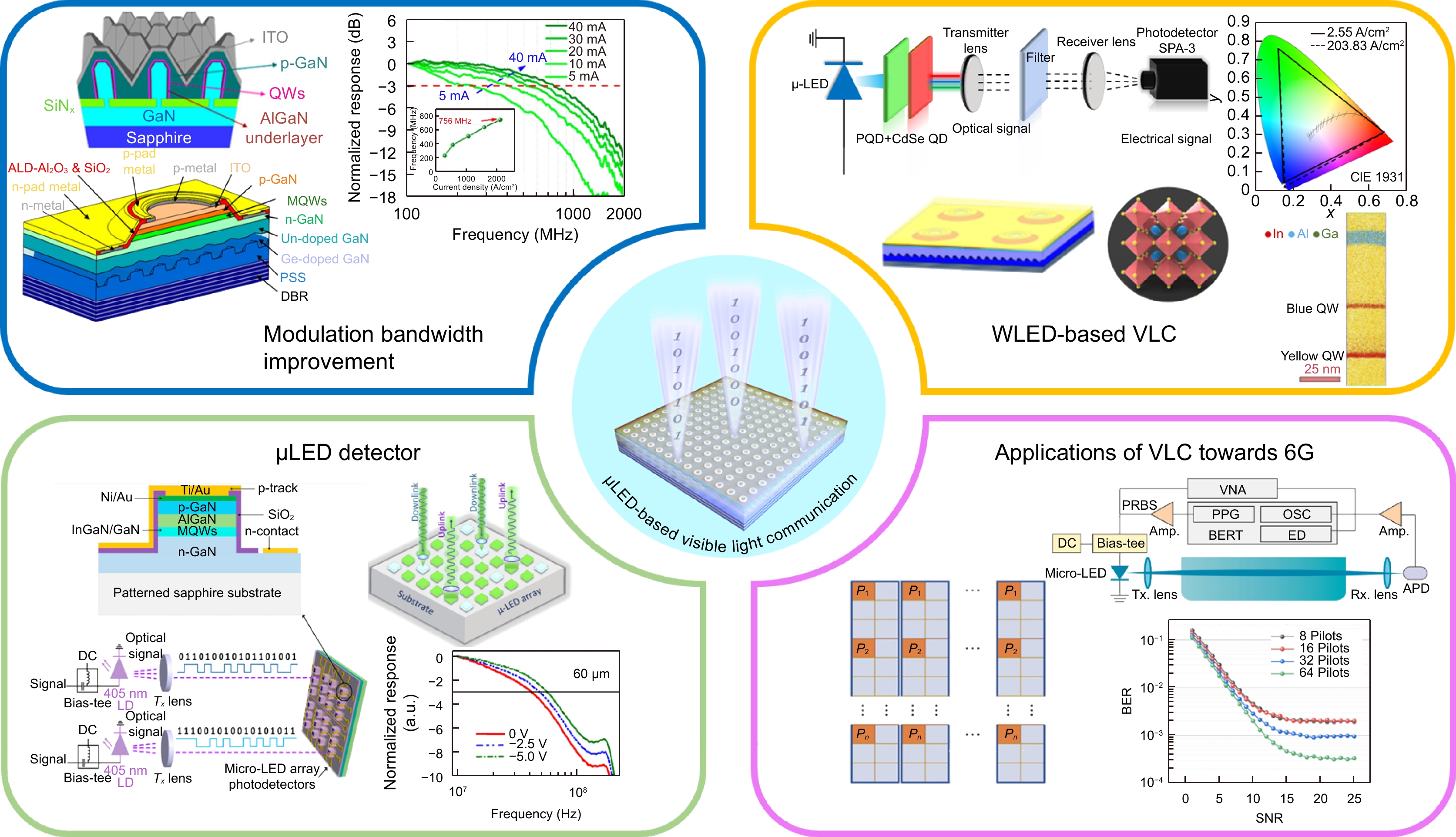

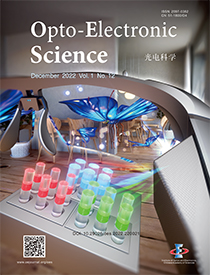
 DownLoad:
DownLoad:

